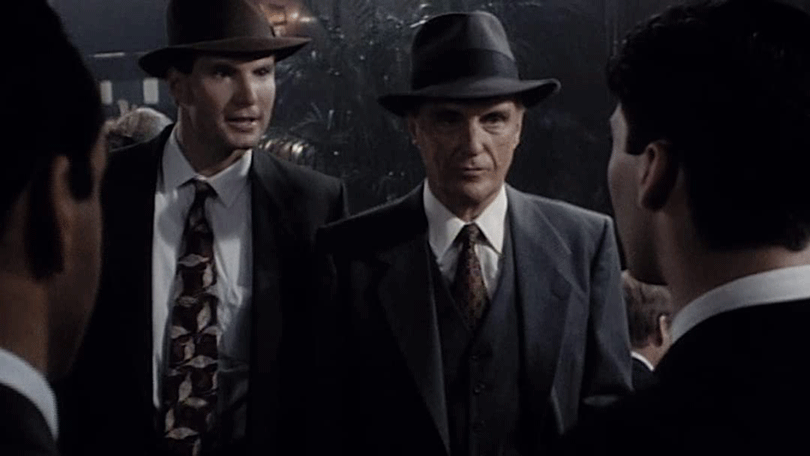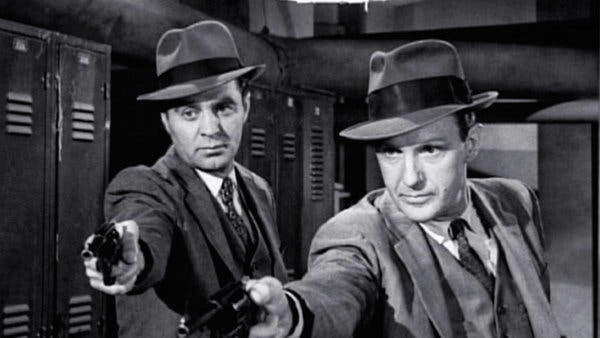Amazon Prime has become a fascinating resource for lost television. Aside from stumbling upon charming oddities like Paul Lynde’s 1976 Halloween Special, you can also find a lineup of forgotten made-for-TV fare (often remastered in 4K). However, there was a deep sadness that came with watching NBC’s The Return of Eliot Ness.
It didn’t come from the sepia-tone images of a long-lost Chicago that opened every act break. It didn’t come from childhood memories of the late Robert Stack hosting Unsolved Mysteries (though, admittedly, that was part of it). It was the realization that they don’t make television like this anymore.

Ness was made for a very specific audience of men and women in retirement communities who wanted a reminder of the Golden Age of Television. But they’re not as young as they used to be, and NBC knows that, so the plot is thoroughly explained more than once. All that truly matters is that an old reliable like Stack is back in familiar territory.
They don’t make films like this for television anymore for a lot of reasons. The market has changed, technology has gone beyond network and The Untouchables isn’t the stalwart reminder of quality television it once was. However, a more haunting truth also remains: They don’t make television like this anymore simply because they don’t care about that audience.
It’s a truth that should be recognized as the United Nations ventures to reduce all inequality in people ageing from 0 to 100 within its Sustainable Development Goals (SDGs). So let’s examine both a relic of a time when television still had a vested interest in that market, and explore the reasons why it doesn’t exist anymore.
Ness opens with a pretty entertaining scene after the generic 1940s montage to establish itself. A bazooka is fired into a racing form house owned by Roger Finn (character actor Charles Durning). Finn has been paying protection to gangster Art Malto, who has taken over Chicago’s organized crime since Al Capone’s fall.
News of Capone’s death from syphilis is just hitting the airwaves.
A former untouchable goes to investigate a lead and is gunned down in a hotel next to Malto’s son’s girlfriend. When word hits that he might have been dirty, it’s up to Ness to come back to L.A. and clear his former partner’s good name.
The plot is standard, but it’s appropriately amped up to justify the TV movie length. It’s worth mentioning this was every sequel plot around the early 90s. Sequels at this time were not seen as the chapters in longer stories they’re viewed as today under Marvel. They were cash-ins, “cheap carny tricks”, as Steven Spielberg said when he was approached to helm Jaws 2.

The Return of Elliot Ness shares more than one similarity with the plot of both Beverly Hills Cop sequels (and the proposed fourth film that’s never gotten out of development hell).
It’s not thrilling television. It’s a subpar TV movie, with a simple plot that could easily be an extended episode of the show, but it had an audience. And the press made no secret of who that audience was. Before it debuted, a premiere piece in The Buffalo News noted that Stack, 74 at the time, was reluctant to compare it to his beloved series.
“Conditioned to nightly brutality on the crime shows,” wrote the News, “Viewers will probably find the story tame. There is no way the new Untouchables is going to shock fans in the tradition of its predecessor.”
But it wasn’t meant to. The rest of the article, and several others like it, made it clear the show was intended for those who wanted to remember Stack in his glory days: “Grim, resilient, noble, Ness never deviated from that one dimension. Fans loved him for it.”
If there’s one thing about the Neilsen ratings with which people are familiar, it’s the much-coveted 18-49 demographic. These are the ages most shows are geared toward. Television with characters that aren’t one-dimensional; that are often anti-heroic. And as television technology has changed, the key demographic hasn’t much.
This is largely the fault of advertisers, who underwood as early as the 70s that people over 55 were less likely to buy products being sold to them. Someone over 55 in the 1970s didn’t have as long a life expectancy as today.
But life expectancy has increased considerably. And while platforms like Netflix don't particularly care how old you are, most of their popular shows are still geared toward that demographic.
While the elderly are still living fulfilling lives, they’re still deprived of their place in the media landscape. Jeff Beer, at Fast Company, suggests the issue might be that advertisers don’t understand how to walk the line between young and old, and without the money there, there’s no compelling business reason to produce things like Ness.
“If you took your entire view of the human race from primetime advertising alone,” Beer writes, “you’d see a society without old people. They don’t work, they don’t drink beer, they don’t drive cars. They don’t exist. According to Havas Group, only about 5 percent of U.S. advertising is even aimed at people over 50.”
That’s to say nothing of the slightly more sensitive factor. Technology is never easy for anyone to stay up to date with, particularly after you reach a certain age. Young people who had to repeatedly instruct their parents how to copy/paste some text on a document will certainly have some familiarity with this.
It’s fitting that we’re talking about a historically inaccurate depiction of a legend who was equally ignored and mistreated in his later years. After arresting Al Capone for tax evasion, Eliot Ness’s career and marriage withered away in Cleveland. After going through two more marriages and an unsuccessful run for mayor, he died of a heart attack at 54.
It was only after the posthumous publication of his book that his heroic reputation grew into what it is today.
One wonders if television advertisers managed to transmit their impulse buys a little more directly, what shows could get the same chance today as The Untouchables did in 1991. There are plenty from the 70s and 80s that have yet to be revisited. It’s not exactly a good sign that the best television can throw any generation are slapdash cast reunions on empty stages where they reminisce.
It should be mentioned that television did find a market for the elderly just four years laterwhen Rupert Murdoch launched a network that even his former acolytes and executives have said has become a weapon to induce fear and panic in their viewers. Murdoch’s network also sells products that would be appealing to the elderly such as erectile dysfunction pills and pillows from a recovering crack addict.
No person, no matter their age, should be deprived of the basic necessities, and while television can’t quite be considered as such, it’s telling when our markets begin to ignore an entire group of people.
For more on the United Nations’ efforts to help reduce inequality, visit the website on Sustainable Development Goal (SDG) 8.
